Steamy Java 2012 Blog
Steam Tour Part 1
Updated 9 August
Steamy Java 2012
DVD (Details Later) |
Our tour leader is Bernd Seiler. His blog is here.
26 July - After lunch we’ll go to the
sugar mill at Olean. In the shed you’ll find four serviceable steam
locomotives and we expect to see at
least one of them in steam doing the line work in the afternoon. We’ll
chase the afternoon train coming
from the fields to the mill. Hotel in Situbondo.
We were somewhat late getting up and down the volcano because of the road to Kawh Ijen. However the Olean locos (diesel No. 1 and steam No. 1) did not go out to the fields until 2:30 so we saw them on their way shortly after departing the mill. The diesel brought out 2 loads for the steam loco off the branch and then headed back to the mill with its own light load. However, it had also left 6 additional wagons on the branch for the steam loco and this proved too much so for the third time for me on this trip, darkness fell before the loco had got further than Patak. The two photos were taken earlier in the afternoon.
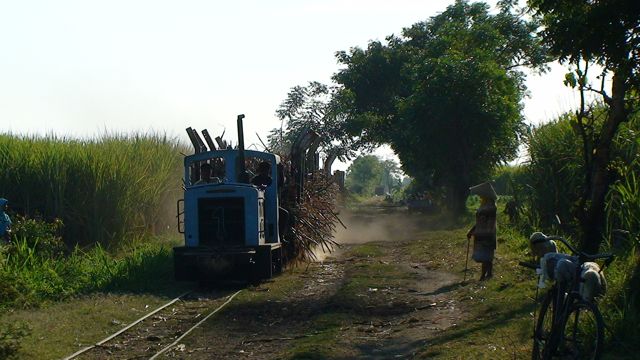
The diesel brings out the second load for the steam loco.
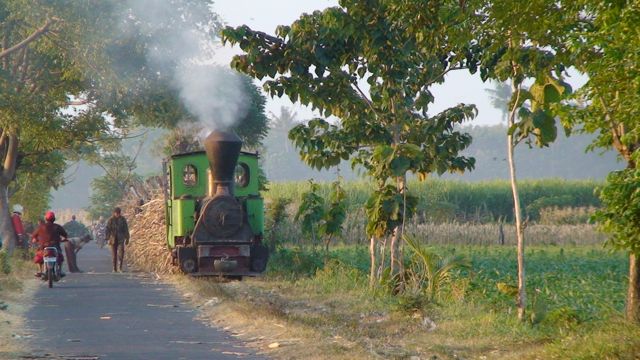
The steam loco departing with its load of 36 lori - at least 6 more than it could comfortably handle.
27 July - The full day is reserved for Asembagus with their
interesting field work which is one of the last two mills
left with frequent daylight steam into the fields. The lines are framed
by palm trees and volcanoes
forming interesting backdrops. Together with some little bridges there
are plenty of photographic
opportunities. However, there is no “steam guarantee” here
either. Late afternoon we’ll return to our hotel in Situbondo.
For those of you who have read my pre-tour blog, this was another partial success/glorious failure! Both the morning and the afternoon action was shortened by the chartered steam loco No. 10 needing to return to the depot with some urgency. In the morning, despite the loco not being ready until 9 am, we managed a run with a train of empties on the line south and then south west. A leaking water gauge in the cab meant we needed a swift return for repairs so that the afternoon train could run. In the afternoon, we went out light engine to the north (straight on rather than left to the port or right towards the forest) around 30 people riding on the loco and tender and, after waiting for empty lori to be taken into a cut field, we headed north and then north west on a route that clearly had not seen a steam loco for some time. The overhanging trees eventually did for us when one clobbered the whistle. When the driver gave the whistle cord a tug to shut it off, it fell out onto the cab roof allowing steam to escape from the boiler. In the safety-conscious west, we would have dropped the fire asap at that point but with a steady escape of steam, they tried various methods to plug the hole without success. Some of our party remained on the tender for a close-up view while others of us retreated a distance and then a safer distance in case the crown sheet collapsed and the boiler exploded. The crew decided to take the loco back towards the mill with the remaining steam and some of us walked behind it (at an increasingly safe distance) while others rode it as far as a village where our transport could pick us up. Diesel No. 5 (the Brookville) came to rescue the steam loco and they were last seen going back to the depot with steam still issuing from the whistle hole of No. 10. As a result, we will have a final go in 2 days' time with this loco if it is repaired in time.
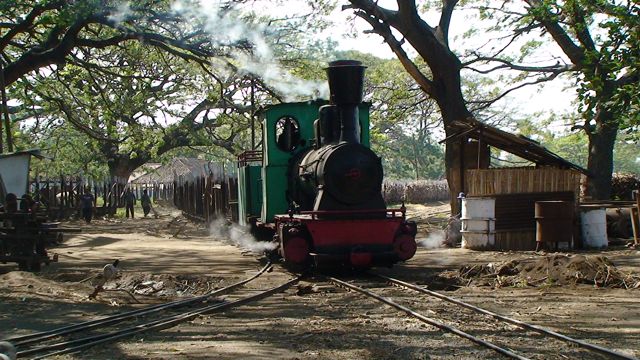
No. 10, having raised steam pressure, in the yard around 9 am.
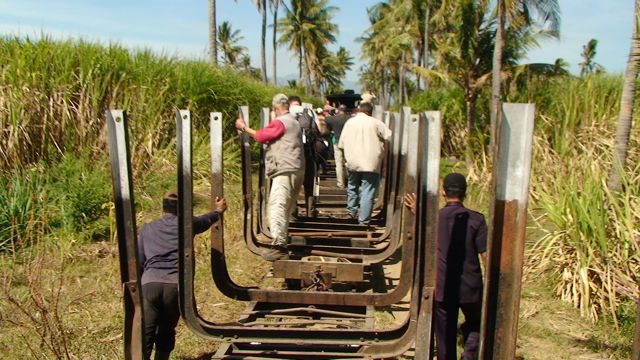
Our method of riding out with the loco - hanging onto the cane lori.
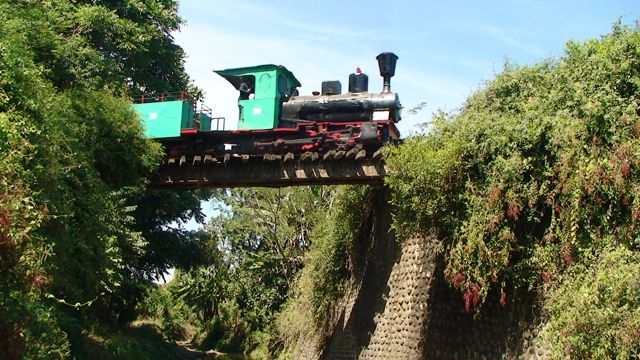
No. 10 on the high bridge on the line to the south west.
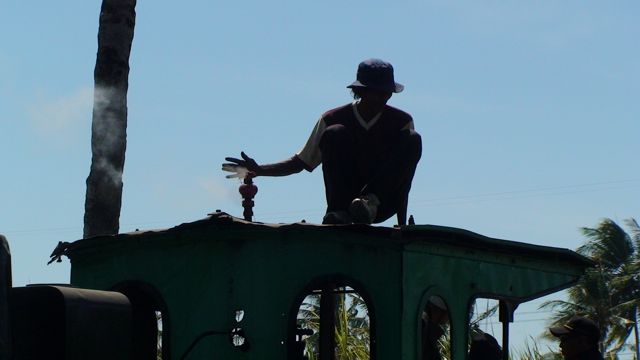
Checking the whistle in the morning. It was still there and working then.
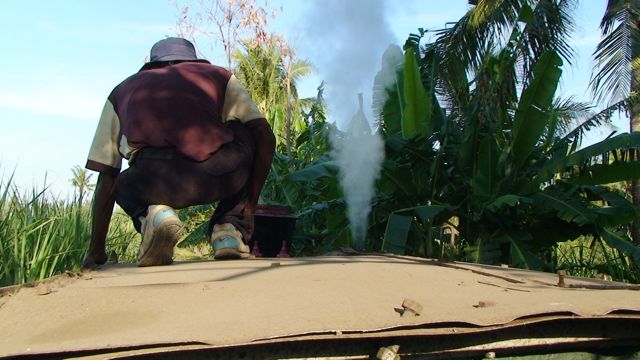
Looking again in the afternoon. By this time it was gone.
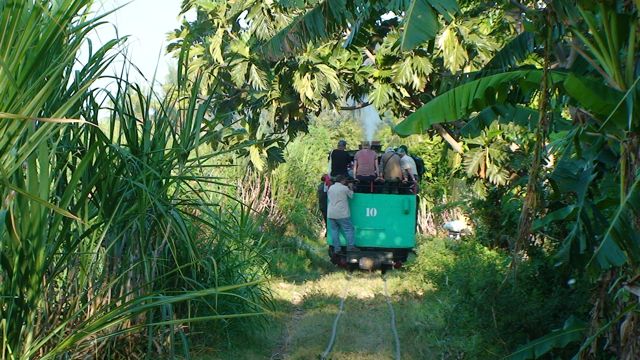
Those who chose to ride the mobile bomb, head to the village.
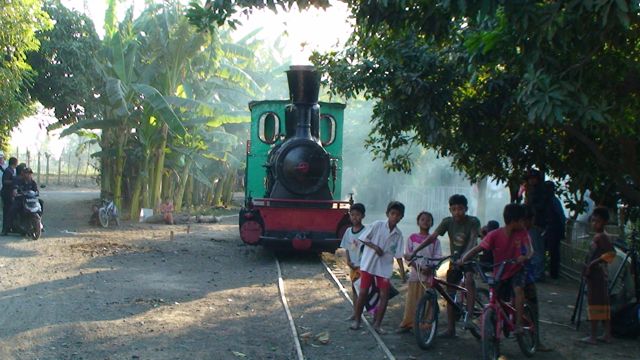
Posed in the village where it could do most damage!
I think the message would be - Don't try this at home in the UK, Germany, Austria, Australia, etc.!
28 July - Another day where we’ll take the chance to see a steam hauled train either on the network of Olean or Asembagus. Hotel in Situbondo.
Today the programme has changed to a full day at Olean. This is still the best mill in Java because of its working collection of stationary steam inside the mill and the 2 working steam locos (one shunting the yard and the other bringing in loaded cane from the fields). However, there are noticeable changes here also. A positive one is the use of steam for line work after a couple of years when line work was normally all diesel. In and around the mill, some steam engines have been replaced by electric motors. A recent replacement is the steam winch used to haul the lori by cable the last few metres to the mill gantry for the mill train. This is now a diesel motor. Bernd reported 2 small steam engines (at least on a high-speed vertical engine) have been replaced by motors since his 2011 visit. On the loco side, No. 5 (with the tender of No. 4) is used to shunt loaded lori to the mill train. No. 1 is the field loco. In addition, both Japanese diesels 1 and 2 are used. Steam loco No. 4 has a 'broken pipe' and No. 7, the other possibly repairable loco, currently has its steam dome removed. All other locos can be considered derelict with No. 2 in an older, darker green paint scheme the only other easily identifiable loco. The afternoon was almost a repeat of my last four visits this trip. The loco eventually left 12 lori behind and with a 12-14 lori load was able to make it to the mill after dark (we assume).
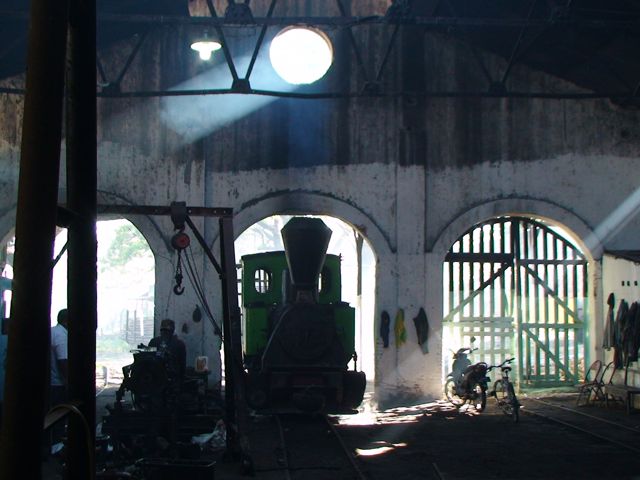
Classic morning shot of No. 1 at the shed entrance.
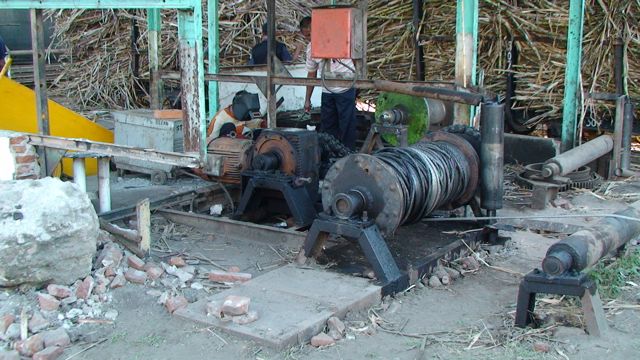
The steam winch has been replaced by an electric motor.
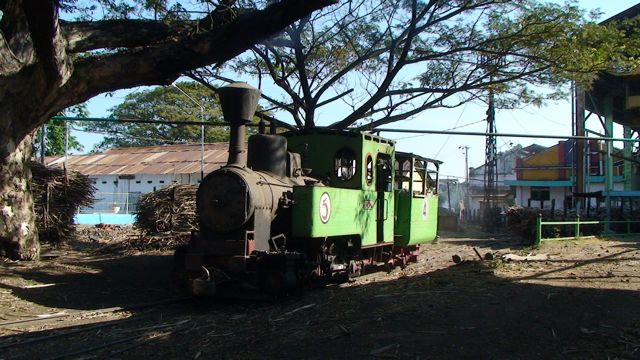
No. 5 returns to haul another set of lori from the cane yard to the mill train. This is a cable operation with the points switched after the loco has crossed to avoid trapping the loco in front of the cane lori.
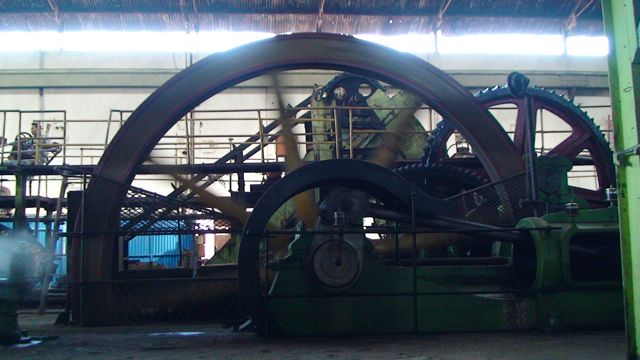
The 6 steam engines in the mill train are still impressive.
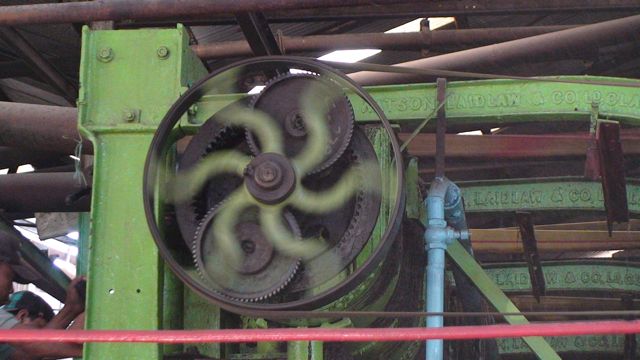
The gearing for the centrifuge operation is still a joy to watch on this ancient equipment from Glasgow.

The processed sugar is bagged roughly to weight (50 kg) and then adjusted on a separate set of scales.
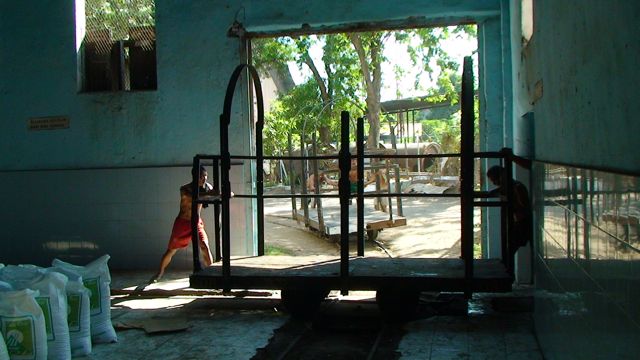
The bagged sugar is then moved to the sugar warehouse on these flat wagons after turning on this wagon turntable. The workers, looking extremely fit, were carrying 2 50 kg bags (100 kg) in one go into the warehouse.
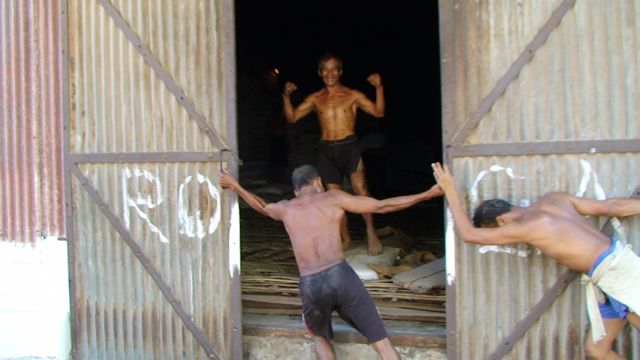
Not much flab on these lads as the ham it up for the camera!
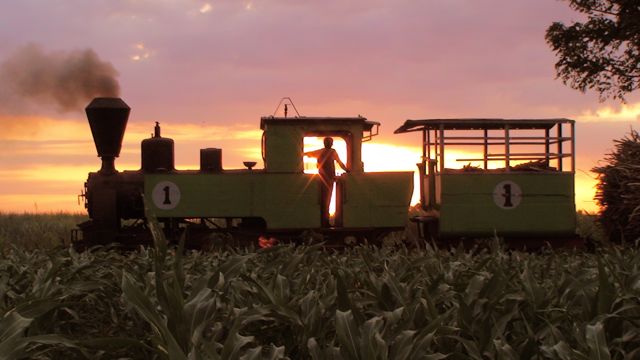
The sun set before the loco departed for the mill.
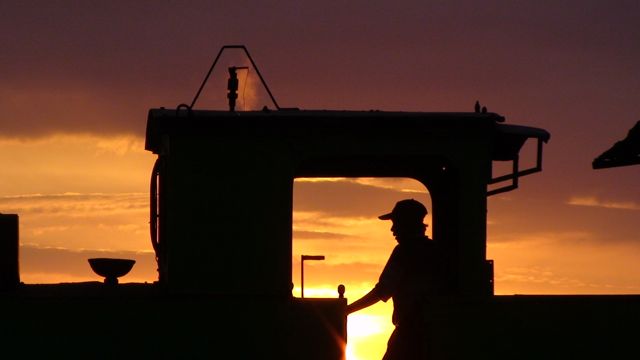
This close up worked better than the full-loco shot
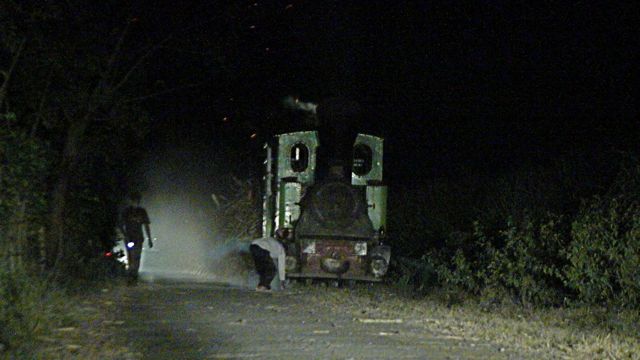
After dark, we achieved this.
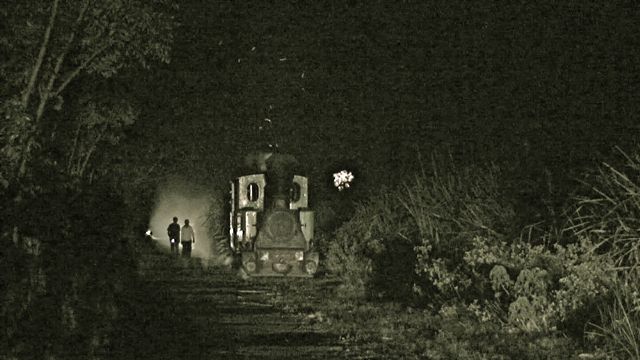
And this. To the right, a rocket celebrates the end of fasting for another day of Ramadan.
29 July - Today we’ll visit the mill at Olean, which
was always known as the only mill with almost guaranteed
loaded daylight trains. Nowadays there is no guarantee as the mill may
use one of their two diesels for
line service. However, the sugar mill is an absolute must because they
use some of the oldest stationary
steam engines (the gems are more than 130 years old). Hotel in Situbondo.
In the late afternoon we’ll
continue to Mt. Bromo (about five hours driving). The famous Gunung (mountain)
Bromo is an active
volcano which offers spectacular views to other volcanoes. The last time
Bromo erupted was last year,
however, chances of seeing such an eruption are very slim. Hotel in Ngadisari,
the last village before the
edge of the crater. Nights can be fresh here, you may need a jumper.
We had an early morning return to Asembagus (6 - 8:30) for a charter with No. 10 and some empty lori on the line directly south. We just about reached the end of the line although the last 1/2 km is not normally used. The loco started the morning with a yellow ring around the smokebox but quickly lost this.
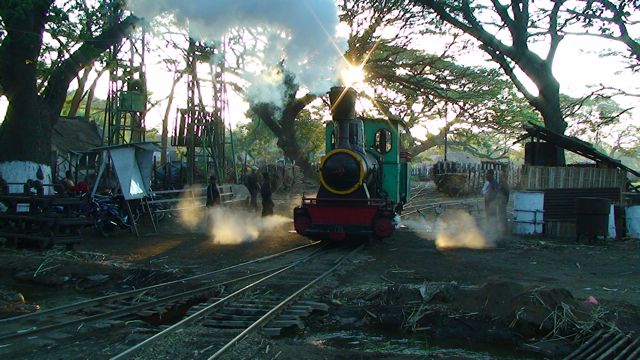
Early morning in the yard. The loco has an newly painted yellow ring to the smokebox.
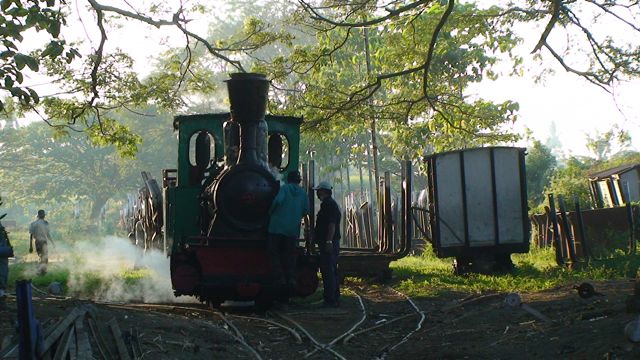
Repainting the smokebox black.
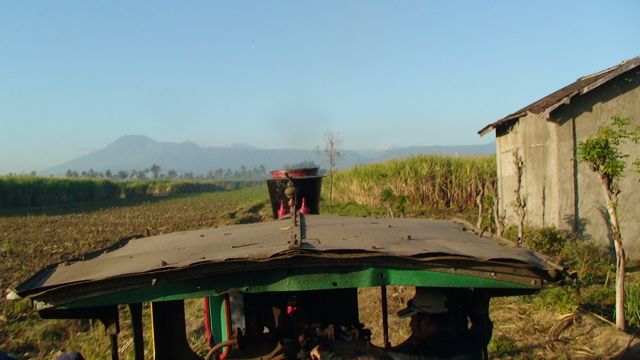
The view from the tender as No. 10 heads south towards Kawah Ijen.
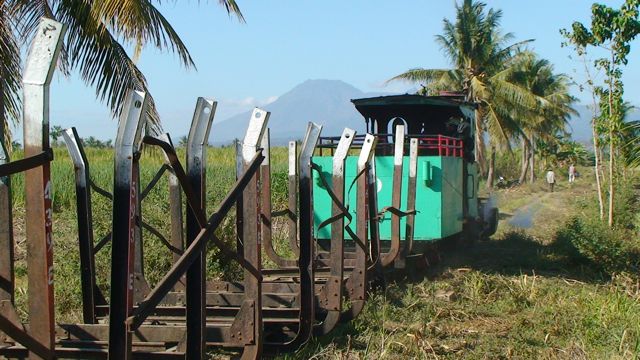
Just about the end of the line with the track becoming progressively more overgrown.
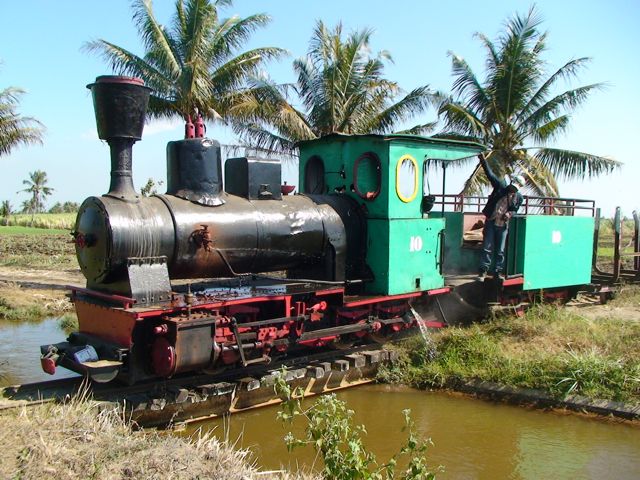
The end of the line at Bantal.
30 July - If you’re going to Java you should not miss
the spectacular view of Mount Bromo at sunrise. To
experience this we have to get up very early. We will climb to the view
point at the top of the volcano for
the best view. You can also hire a seat in a 4WD Jeep for some 9 Pounds
to avoid a walk of about 500
yards upwards and two miles in length. In the afternoon we’ll continue
to Kediri (about five hours driving).
On the way we’ll stop in Krembung, where we expect to see five Schöma
and one O&K diesel. Hotel in
Kediri.
My last visit to Bromo was in 1984 when we came up from the Malang side. In the intervening 28 years, much has changed with jeeps and motorcycles replacing horses for transportation inside the crater and I believe that Bromo has erupted a couple of times since then. The whole tourist infrastructure has grown but considering we were at a major general tourism destination, it could have been a lot worse!
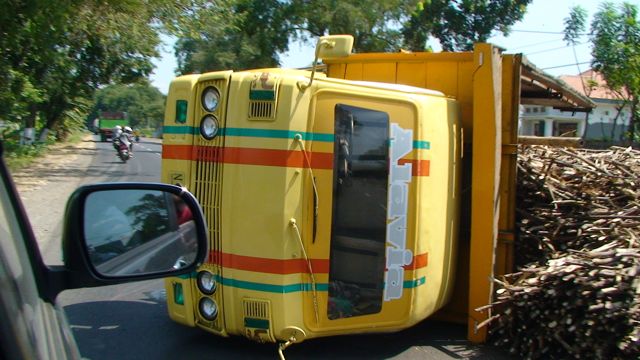
On our way to Bromo, this cane truck had tipped on its side partially blocking the road.
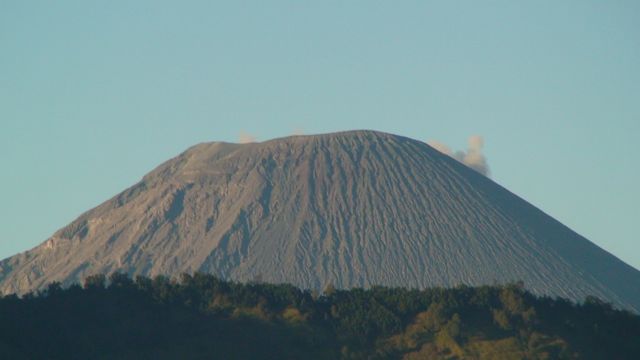
Mount Semeru seen from the crater rim at Bromo. This used to erupt quite spectacularly every 11 minutes but these days the activity is less dramatic and less frequent.

Close up view of the effect of rain on the volcanic dust and sand in the crater area.
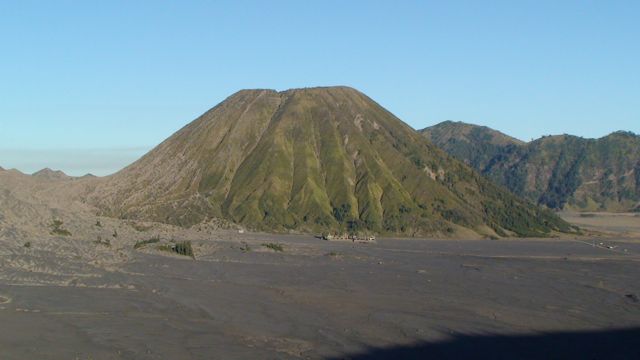
Inside the crater, Mt Batok is the classic volcanic cone with the still active but not very photogenic Mt Bromo off-picture to the left.
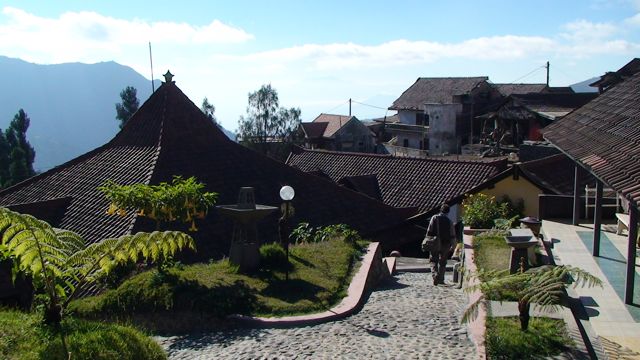
The view from my room at the Cafe Lava Hostel at Ngadisari village reminded me both of Nepal and Bali - Nepal for the mountain village architecture and views and Bali for the grass, fern trees and flowering datura bushes in the hotel grounds. Hinduism is the dominant religion in this village.
On our way to Kediri we passed Kedawung and found 3 locos waiting to cross the main road and the State Railway. We continued to Krembung (Kremboong) and found 4 locos in use along with several tractors. The mill train here is short with only 3 engines - one quite small. There is a big contract between the steam mill train and the much cleaner electric sugar processing and bagging side of the mill. Around the back of the mill and within the mill compound, a major new building multi-storey is under construction but its future function wasn't clear.
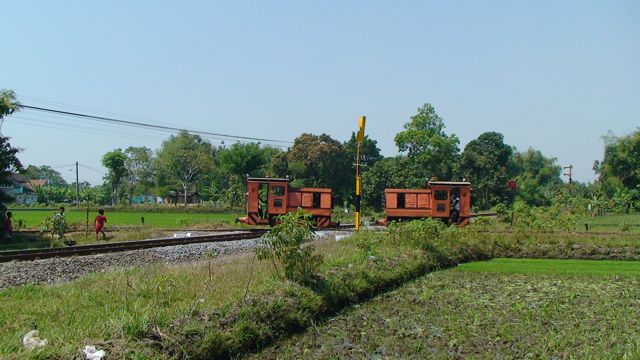
At Kedawung, 2 locos cross the State Railway going to the fields to the north.
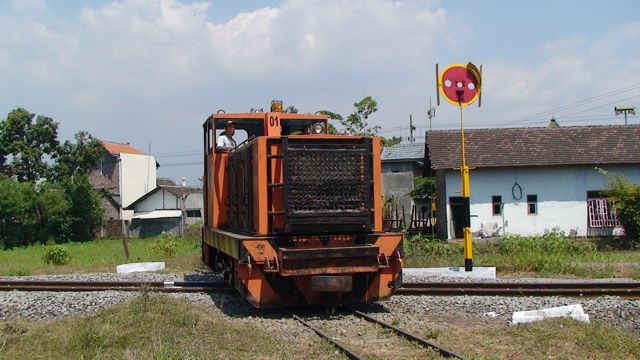
Japanese diesel with a train of empties at the same crossing.
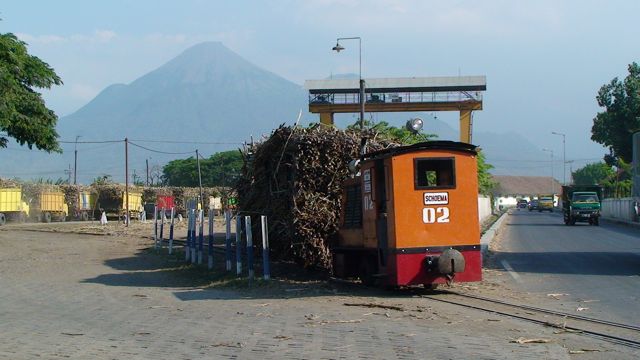
At Krembung, Schoema No. 2 brings a cane train to the mill from the truck yard with Mt Penanggungan behind.
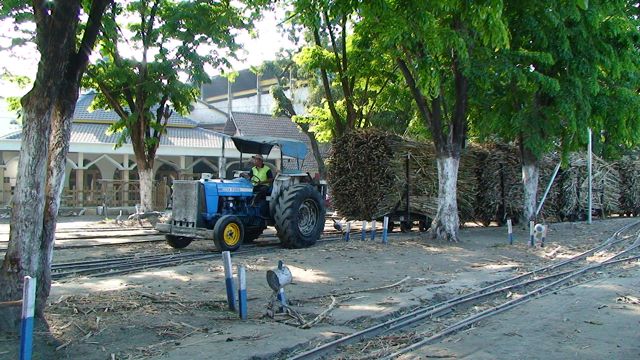
Tractors do around 50% of the work (including working the ash train).
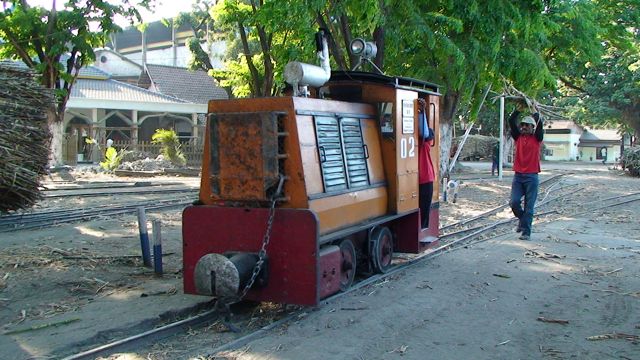
Schoema No. 2 seen from the front.
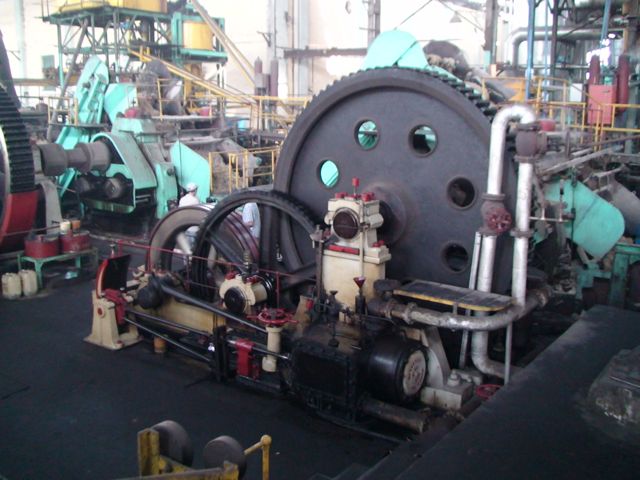
The smaller middle engine in the mill train was built by Werkspoor (No. 910 of 1908).
31 July - Today we’ll visit the mill of Merican. Here
we’ll meet either the last 0-4-2 locomotives of Indonesia or the
last non-tourist Mallet, used for heavy shunting operations. They have
over 100 years of service! Around
10am the participants with a general interest in light railways will take
one bus to go to Mojopanggung
were we’ll find three O&K, a Schöma and last but not least
a Baldwin! In the afternoon we’ll continue to
Rejoagung. This mill owns six Diema, nine Schöma and three dumped
O&K. In the evening we’ll
continue to our hotel in Madiun, were both groups will meet again.
Merican decided to only use tractors this season and didn't overhaul the steam locos in the off season. For that reason, they were unable to steam a loco for our group. A unanimous decision was taken to skip Merican and just do the other two mills. At Mojopanggung, loco No. 1 was in use hauling the empty wagons out from the mill and pushing them back to the truck yard. All other work was tractor. In 2010, bullocks were used as well. See my 2010 blog for contrasting shots.
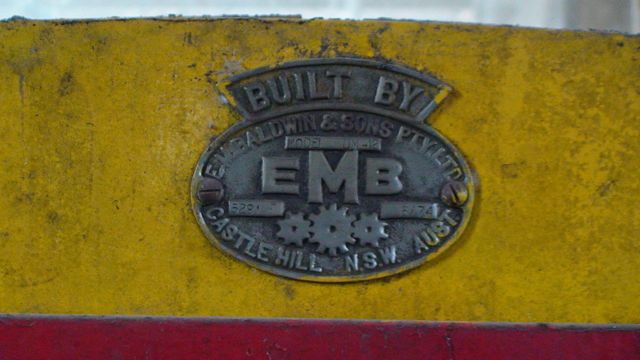
Works plate for the Baldwin diesel.
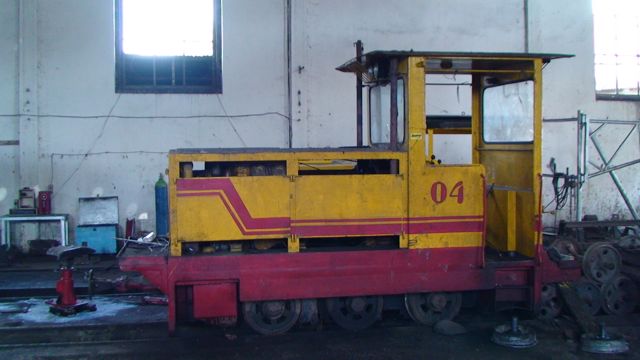
The Australian Baldwin probably hasn't moved since our 2010 visit.
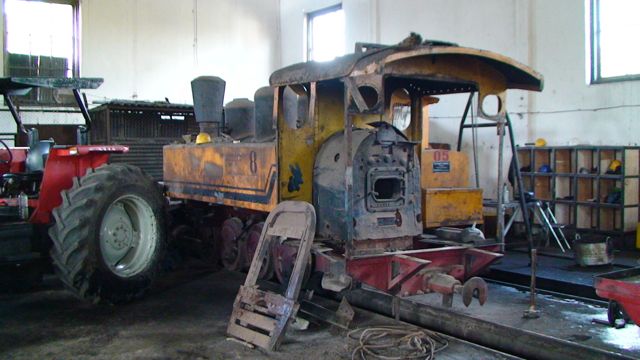
Nor has the American Baldwin.
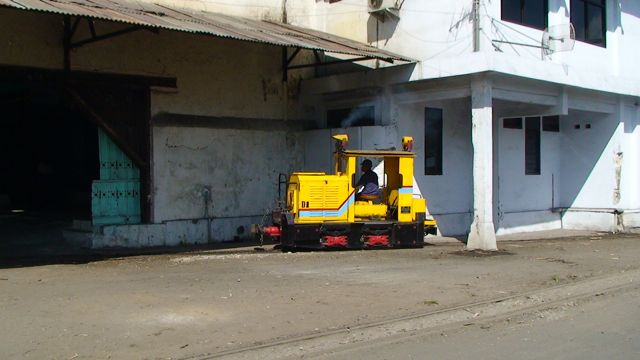
O&K No. 1 worked the empty lori from the factory.
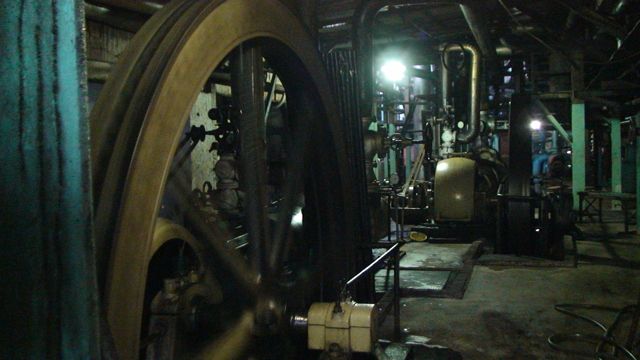
In the mill, we only found two steam pumping engines at work, steam turbines produce electricty to power the rest of the mill.
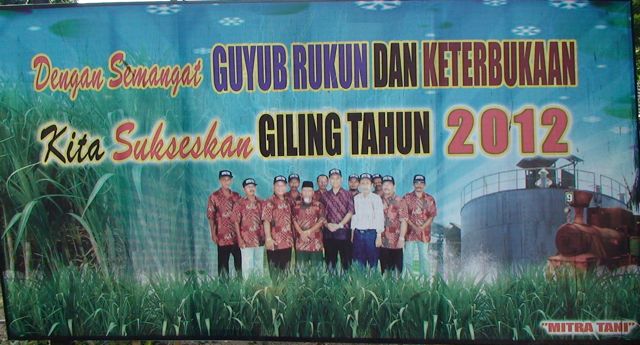
The poster for the 2012 season. Not sure where loco No. 9 was 'borrowed' from. Note the tank for an oil burner.
In the afternoon, we went to Rego Agung. This mill employs 7,000 workers during the season (roughly May - September) and is said to be the biggest producer in the Madiun area. The mill stopped using steam around 1980 and stopped using its field lines in the late 1990s/early 2000s.
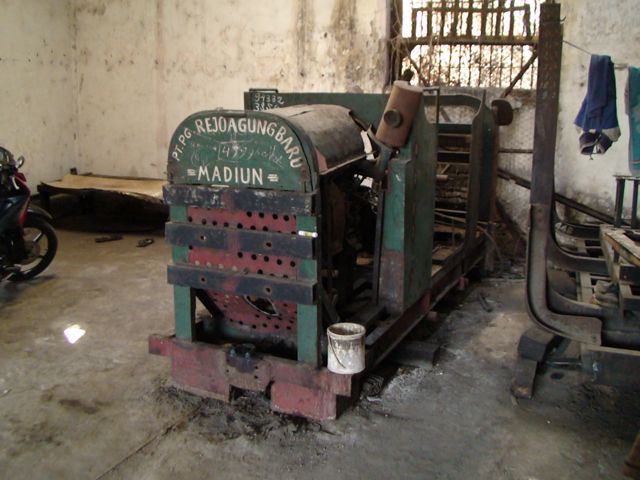
Another view of the home-made loco. Compare this with the 2010 shot from the other side.
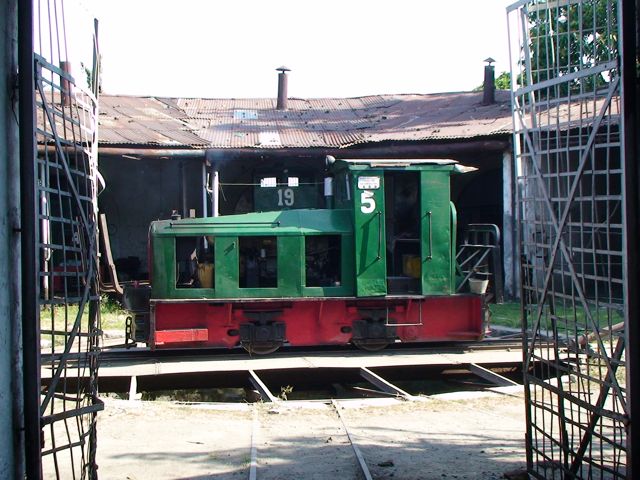
No. 5 was turned and posed on the turntable.
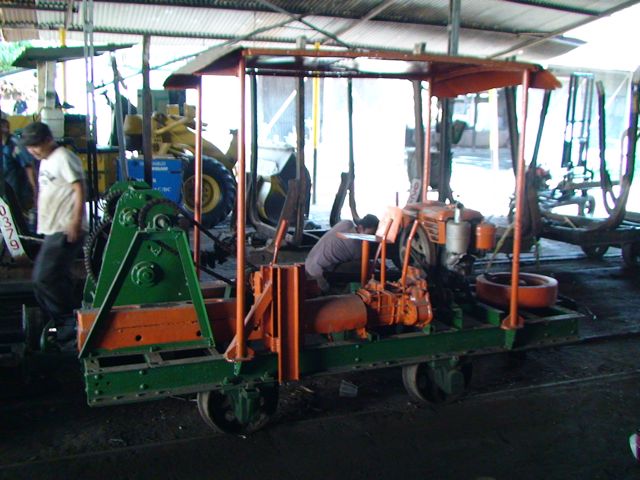
New home-made loco (one of 2) with a winch and 2 Yanmar engines. This was in the lori repair shed.
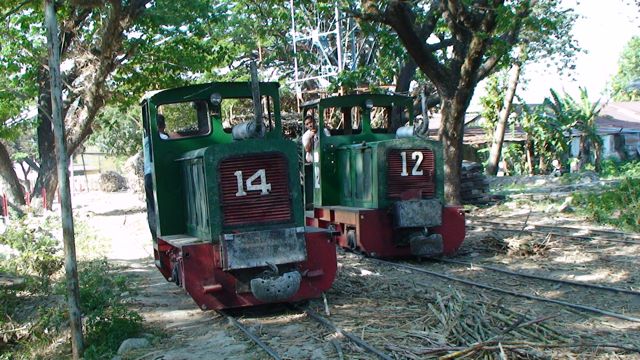
The locos spend a long time on short trains waiting to shuffle to the mill or waiting to go back for more cane.
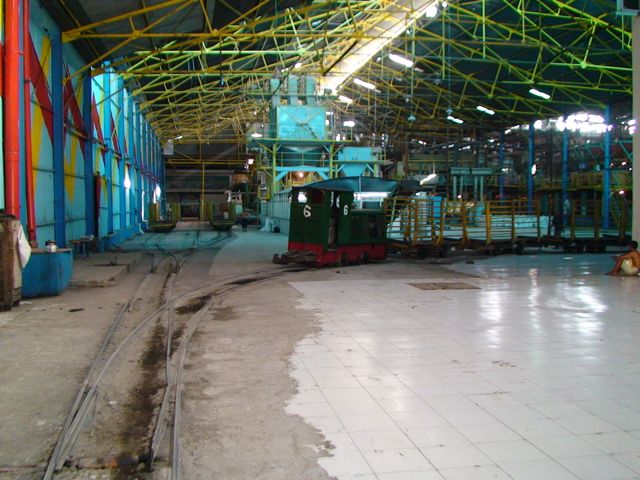
No. 6 inside the sugar bagging and loading area. This is significantly more mechanised than (say) Olean.
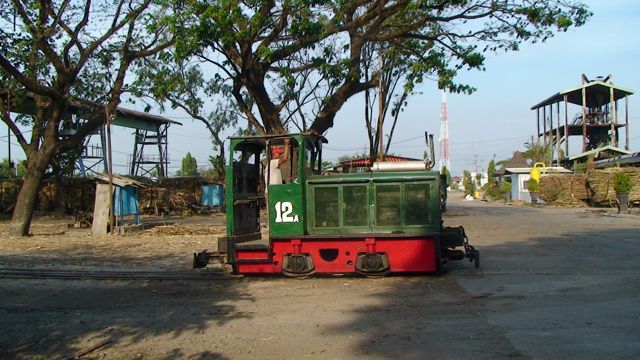
No. 12A, the A probably signifying it came from another mill. We think 1A came from Krebut Baru but don't know about 12A. (According to John Browning, 12A is really No. 13 - unlucky number - and is not from elsewhere,)
To read more about the steam tour, click here for part 2 (coming soon on or after 1 August).
You can contact me at john@linesiding.co.uk